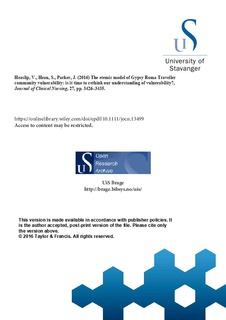| dc.contributor.author | Heaslip, Vanessa | |
| dc.contributor.author | Hean, Sarah | |
| dc.contributor.author | Parker, Jonathan | |
| dc.date.accessioned | 2019-08-21T11:34:36Z | |
| dc.date.available | 2019-08-21T11:34:36Z | |
| dc.date.created | 2016-12-05T13:13:22Z | |
| dc.date.issued | 2016-08 | |
| dc.identifier.citation | Heaslip, V., Hean, S., Parker, J. (2016) The etemic model of Gypsy Roma Traveller community vulnerability: is it time to rethink our understanding of vulnerability?, Journal of Clinical Nursing, 27, pp. 3426–3435. | nb_NO |
| dc.identifier.issn | 0962-1067 | |
| dc.identifier.uri | http://hdl.handle.net/11250/2609515 | |
| dc.description | This is the peer reviewed version of the following article: Heaslip, V., Hean, S., Parker, J. (2016) The etemic model of Gypsy Roma Traveller community vulnerability: is it time to rethink our understanding of vulnerability?, Journal of Clinical Nursing, 27, pp. 3426–3435., which has been published in final form at https://onlinelibrary.wiley.com/doi/epdf/10.1111/jocn.13499. This article may be used for non-commercial purposes in accordance with Wiley Terms and Conditions for Use of Self-Archived Versions. | nb_NO |
| dc.description.abstract | Aims and objectives
To present a new etemic model of vulnerability.
Background
Despite vulnerability being identified as a core consequence of health and health experiences, there has been little research exploring the meaning of vulnerability as a concept. Yet, being vulnerable is known to have dire physical/mental health consequences. It is therefore a fundamental issue for nurses to address. To date, the meaning of the term vulnerability has been influenced by the work of Spiers (Journal of Advanced Nursing, 31, 2000, 715, The Essential Concepts of Nursing: Building Blocks for Practice, 2005, Elsevier, London). Spiers identified two aspects of vulnerability: the etic (external judgment of another persons’ vulnerability) and the emic (internal lived experience of vulnerability). This approach has led to a plethora of research which has explored the etic (external judgment) of vulnerability and rendered the internal lived (or emic) experience invisible. Consequences of this, for marginalised communities such as Gypsy Roma Travellers include a lack of culturally sensitive services compounding health inequalities.
Design
Position paper.
Method
Drawing upon a qualitative phenomenological research study exploring the lived experience of vulnerability from a Gypsy Roma Travelling community (published previously), this paper presents a new model of vulnerability. This etemic model of vulnerability values both external and internal dimensions of vulnerability and argues for a fusion of these two opposing perspectives.
Conclusions
If nurses and other health‐ and social care professionals wish to develop practice that is successful in engaging with Gypsy Roma Travellers, then there is a need to both understand and respect their community. This can be achieved through an etemic approach to understanding their vulnerability achieved by eliciting lived experience alongside the appreciation of epidemiological studies.
Relevance to clinical practice
If nurses and health practitioners used this etemic approach to practice then it would enable both the development and delivery of culturally sensitive services facilitating health access to this community. Only then, will their poor health status be successfully addressed. | nb_NO |
| dc.description.sponsorship | © 2016 John Wiley & Sons Ltd | nb_NO |
| dc.language.iso | eng | nb_NO |
| dc.publisher | John Wiley & Sons Ltd. | nb_NO |
| dc.relation.uri | https://onlinelibrary.wiley.com/doi/epdf/10.1111/jocn.13499 | |
| dc.subject | sosialt arbeid | nb_NO |
| dc.subject | Romfolk | nb_NO |
| dc.subject | sigøynere | nb_NO |
| dc.subject | sårbarhet | nb_NO |
| dc.subject | helsestell | nb_NO |
| dc.subject | mental helse | nb_NO |
| dc.subject | psykisk helse | nb_NO |
| dc.subject | sykepleie | nb_NO |
| dc.subject | Irske reisende | nb_NO |
| dc.subject | marginaliserte folkeslag | nb_NO |
| dc.title | The etemic model of Gypsy Roma Traveller community vulnerability: is it time to rethink our understanding of vulnerability? | nb_NO |
| dc.title.alternative | The etemic model of Gypsy Roma Traveller community vulnerability: is it time to rethink our understanding of vulnerability? | nb_NO |
| dc.type | Journal article | nb_NO |
| dc.type | Peer reviewed | nb_NO |
| dc.description.version | acceptedVersion | nb_NO |
| dc.subject.nsi | VDP::Medical disciplines: 700::Health sciences: 800::Nursing science: 808 | nb_NO |
| dc.source.pagenumber | 3426-3435 | nb_NO |
| dc.source.volume | 27 | nb_NO |
| dc.source.journal | Journal of Clinical Nursing | nb_NO |
| dc.source.issue | 17-18 | nb_NO |
| dc.identifier.doi | 10.1111/jocn.13499 | |
| dc.identifier.cristin | 1408309 | |
| cristin.unitcode | 217,7,3,0 | |
| cristin.unitname | Institutt for sosialfag | |
| cristin.ispublished | true | |
| cristin.qualitycode | 2 | |
